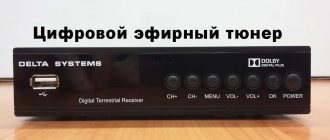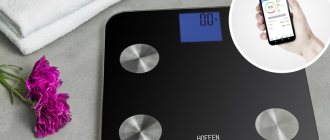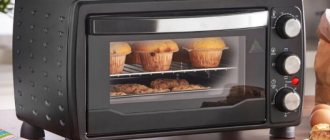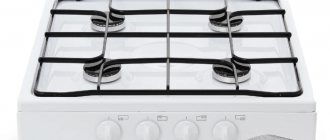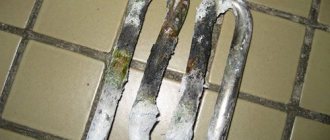Cleaning the oven from grease and burnt food is one of the most time-consuming household tasks. To facilitate cleaning, modern stoves use catalysis, pyrolysis and hydrolysis processes.
The most effective method is considered to be catalytic cleaning of the oven, which allows you to oxidize fat directly during the cooking process - we will explain what this is later.
What does it mean?
Catalysis is the acceleration of a chemical process that occurs under the influence of a specific substance (catalyst). During the reaction, this substance does not change its properties and composition, which ensures the possibility of repeated use.
The catalytic cleaning method is based on the rapid oxidation of fat that settles on the oven walls during baking.
The end products of this reaction are carbon and water, but other organic substances can also form if the temperature is too low. After the oven has cooled, dirt can be removed with a sponge or microfiber cloth .
To make cleaning easier, special panels are installed on the walls of the device. They are treated with enamel, which has large pores and contains a catalytic substance. The porous surface increases the contact area between the fat and the reagent. Compounds of cerium, copper, cobalt and manganese act as catalysts.
Catalyst substances do not mix with reaction products , so cooking in an oven with special enamel is completely safe.
The traditional method of cleaning the oven - what is it?
Perhaps the last method to achieve cleanliness inside the oven is the traditional method, which involves the use of industrial detergents, a sponge or rag and your own hands. According to most housewives, this method is the most costly in terms of effort and time. To obtain purity, not only store-bought formulations are used, but folk recipes (lemon juice, vinegar, soda) can also be used.
Advantages and disadvantages of the traditional method
When talking about the mechanical method of removing fat and contaminants, the disadvantages should be listed first, since they are more obvious than the advantages. The disadvantages of this method include:
- mechanical nature of the work;
- separate cleaning of all parts, including the door;
- products containing an insufficient amount of abrasive do not remove grease well, and the use of powders can damage the surface;
- Harsh chemicals leave an odor.
In every kitchen there are components for creating a folk recipe for cleaning the oven. The advantages of this type of cleansing are:
- minimal costs, since the purchase of a special oven is not required;
- no waste on electrical energy.
How to clean an oven using grandma's methods
Every housewife has components in her kitchen that allow her to clean the oven in the traditional way. These include:
- soda;
- vinegar;
- salt;
- lemon.
A paste of soda and vinegar leads to a violent reaction, which results in the removal of greasy deposits. From water, vinegar and soda, you can prepare a solution that cleans old grease well if you leave it on the surface for two to three hours and then remove it with a rag. Regular vinegar can be used for steam cleaning by leaving a heatproof container inside the oven and heating it to 200°C.
Using citric acid involves mixing it with a small amount of vinegar. The resulting solution should be used to treat the walls, which are preheated to 100°C. Another component for preparing a cleansing paste is hydrogen peroxide, which is mixed with baking soda. The resulting composition is applied to the walls for 4 hours, after which it is washed off with enough water.
The most effective method is pyrolysis, which allows you to turn even the dirtiest surface into a new one.
How is the oven cleaned?
Catalytic cleaning does not require specific preparation. During the cooking process, small drops of fat fall on the walls of the oven and are distributed over the porous surface, which absorbs dirt.
Oxidation begins at relatively low temperatures (from +140...150°C) , but most effectively occurs at a temperature of +200...250°C.
Lipid decomposition occurs simultaneously with food preparation. While maintaining the required temperature, the catalyst oxidizes adhering fat and dirt until a new layer settles.
At the end of the process you must:
- wait for the oven to cool completely;
- remove the grill or baking tray;
- wipe the working panels with a soft sponge or cloth;
- wash other surfaces.
If necessary, you can postpone cleaning the oven and immediately start cooking another dish. It may take several cleaning cycles to remove old and thick layers of grease.
As a rule, catalytic panels are installed on the walls of the oven (top, back and sides), as well as the convector. The bottom and inside of the door must be cleaned using traditional methods.
These limitations are due not only to the cost of the panels, but also to their instability to glucose. If the enamel also covers the bottom of the oven, then dripping sweet juice or caramel can damage the coating.
conclusions
What is the best type of oven cleaning? Everyone finds the answer to this question themselves. In some cases you save time, and in others you save money and electricity.
When considering various options, to make a final decision, find for yourself the answer to the question: what is more important, savings or your own comfort?
Is it better for you to pay more and buy a unit with pyrolytic cleaning so as not to worry about the condition of the oven, or invest less money and still put in the effort to keep it clean?
If you use your oven occasionally, you won't have to clean it often, and an economical option will do just fine. But in any case, the choice remains with the hostess.
Author: Sergey Vladimirovich, electrical engineer. More about the author.
Terms of use
To maintain the functionality of catalytic panels you need:
- If sugar or dairy products come into contact with the surface, wipe off the stains as soon as possible with a soft, damp sponge.
- Do not use hard scourers, metal scrapers or acid-based products to clean the oven.
- Avoid contact of sharp metal objects and enamel.
- Choose gels and liquid products for cleaning, and immediately after catalytic oxidation, wipe the coating only with a damp sponge without detergent.
If necessary, catalytic panels can be cleaned with cleaning products based on alkalis and surfactants.
Catalytic self-cleaning
The basis of the operating principle of this technology is the decomposition of fat accumulated after cooking into soot and water, which will then be absorbed by sorbent particles. The bosch oven self-cleansing occurs as soon as you turn on the oven and set the temperature to at least 140 degrees. The technology achieves maximum efficiency at 200 degrees. You don't need to enable, activate or do anything additional. The process is completely automatic.
- Cabbage pie is quick and easy
- Fine for driving without insurance
- How to cook cauliflower - how long
Pros and cons of the method
The catalytic oven cleaning method has a number of advantages:
cleaning up dirt can be combined with cooking, since the operating temperature of catalytic oxidation ranges from +200°C;- the catalysis process does not require large amounts of electricity or gas;
- reagents in enamel are completely safe for products;
- catalysis removes not only fresh, but also old fat, so cooking at maximum temperatures is not necessary all the time;
- ovens with a catalytic cleaning system can be either electric or gas.
The cost of such devices varies depending on the manufacturer, power and panel configuration. Ovens with catalytic cleaning are available in all price categories.
The disadvantages of the method include the following aspects:
- this method is intended only for removing fat, but is ineffective against other types of contaminants (sugar, milk protein, etc.);
- the panels have a short service life (200-300 hours), after which they need to be replaced;
- For effective cleaning, you need to turn on the high-temperature mode regularly.
Panels with a catalyst are sold separately from ovens; you can replace them yourself or at a household appliance service center.
What type of oven cleaning is best?
The presence of a large number of methods for cleaning the oven makes it difficult to choose which one is most effective. There is no definite answer here, since each housewife chooses a method that is convenient for herself. The only thing that can be noted is that the least popular is the traditional method.
Which oven cleaning is better: catalytic or steam?
In this “duet”, the palm goes to the catalytic method, since its use allows you to cope with even the oldest fat, without requiring a significant investment of time or electrical energy. Steam cleaning is only useful when there is fresh grease that needs to be cleaned quickly. But here gentle household chemicals will come to the rescue.
One of the disadvantages of pyrolysis is the need to remove all unnecessary fasteners from the oven.
Which oven cleaning is better: catalytic or pyrolytic?
A comparison of these two methods, in which cleaning is carried out using temperature conditions, will be in favor of pyrolysis, since this technology allows you to completely clean the surface of the oven without human intervention. Even despite strict safety and equipment requirements, pyrolysis is a more effective method.
When choosing an oven, you need to pay attention not only to its appearance, but also find out about the cleaning method
Which method is better - mechanical, steam, manual or pyrolysis?
In addition to catalysis, the purification system can be based on the following processes:
- hydrolysis of fats;
- mechanical removal of contaminants (traditional method);
- pyrolysis;
- rejection of fat molecules by a smooth, non-porous surface (enamel for easy cleaning).
Advantages and disadvantages of other purification methods compared to catalysis:
| Method | a brief description of | Advantages | Flaws |
| Pyrolysis | Complete fat burning at temperatures up to 500°C | It is highly efficient. No need to change working panels | Requires a lot of energy. An additional warm-up operation is required. It has a high cost. Reliable door locking system required |
| Hydrolysis | Softening fat with water vapor at 90°C | Can be used in the simplest and most budget oven models. No replacement parts. Occurs at low temperatures. Can be used for any type of contamination | Additional heating with steam and mechanical cleaning are required afterwards. Fat is removed only after the surfaces have cooled. Ineffective against old fat |
| Easy clean enamel | Manual cleaning of the surface with a soft sponge | The coating is resistant to acids and sugar. Enamel protects all interior surfaces of the oven | This enamel is more sensitive to scratches and damage and cannot be replaced. If the coating is damaged, corrosion of the base metal occurs |
| Traditional | Mechanical cleaning with a sponge and solutions of soaps and alkalis | Can be used in all types of ovens. Does not require special coating. Efficiency does not depend on the nature of contamination | Using abrasives may damage the anti-corrosion layer. Labor-intensive, low efficiency. Requires hand protection due to the use of alkalis |
Some oven models are equipped with a catalytic hydrolysis cleaning system, which makes it easy to clean all surfaces even at low temperatures. Read about hydrolysis cleaning here, about traditional cleaning here.
The principle of pyrolytic purification
Many buyers are interested in what is the difference between pyrolytic and catalytic oven cleaning.
The benefits of purchasing an oven with pyrolysis technology raise some doubts
Pyrolysis is the breakdown of substances due to exposure to high temperatures. Leftover food burns completely, turning into ash and soot.
The benefits of purchasing an oven with pyrolysis technology raise some doubts. Such models have the highest cost compared to other types of food residue removal. On average, the price category is 2 times higher than the cost of other middle-class ovens.
This is due to the quality of the material used to decorate the interior walls. The doors have additional protection against burns.
This type of cleaning is present only in electrical units. Pyrolysis is not economically viable due to the high level of energy consumption. When installing, it is important to consider that the power cable voltage must be 6000 V.
The exception is ovens with “6th sense” technology. Its essence is that the device reacts to the concentration of carbon dioxide, which is released during combustion. When its level begins to decrease, the process stops.
Pyrolysis has its economic advantages. Such ovens serve for a long time without breaking down and do not require frequent replacement of expensive parts. Most of these models are equipped with a self-cleaning function, which significantly reduces the costs required to purchase detergent.
How to use?
How to use an oven with pyrolysis function:
- Remove the kitchen utensils that are in it, take out the baking sheets and racks.
- Select the required mode on the control panel based on the degree of contamination, press the “Start” button. When the temperature rises to 300 degrees, the door will lock to prevent burns. It will be possible to open it again when the cleaning process is completed: the temperature begins to drop and reaches 200 degrees.
- After cooling, remove the resulting ash with a brush, then wipe the surface with a soft cloth.
When using the oven daily, pyrolysis is carried out at least once every 7 days.
Modern models are equipped with additional functions that will help make working with the device easier:
- The presence of a filter that automatically starts the cleaning process after 100 hours of operation.
- Built-in sensor system that tells the housewife that it is time to remove dirt.
- Step-by-step instructions for cleaning the oven, which are displayed on the digital display.
Be sure to read:
How to connect a gas stove with your own hands: step-by-step instructions, installation rules
Ovens with pyrolysis appeared quite recently, but during this time they have evolved.
| Mode | Purpose | Working hours |
| Minimum | Used in cases of light contamination | 2 hours 15 minutes |
| Ordinary | Medium difficulty | 2 hours 40 minutes |
| Maximum | If there is a thick or old layer of fat | 3 hours 15 minutes |
Gradually, almost every manufacturer of household appliances began to produce models based on the needs of customers and use a catalytic filter, which allows them to quickly burn large contaminants and save energy consumption.
Some manufacturers produce ovens in which food is burned in several levels. This allows you to avoid heating the device to maximum temperatures.
Pyrolysis ovens are the highest quality appliances.
This is explained by the fact that high combustion temperatures require appropriate quality material. For the manufacture of such devices, only the highest quality steel is used. The walls and bottom are covered with special enamel that can withstand high temperatures.
The door glass is completely safe. This is achieved thanks to the presence of 3 or 4 tempered glasses. The door locks during operation. The case is equipped with a cooling system, but it is important to consider that the temperature of the device can reach 100 degrees or higher.
There is a safety system inside the unit in case of fire. To do this, sensors are installed that record temperature and carbon monoxide concentrations.
Some brands of ovens have filters that are located on the convector grill. Their task is to protect the fan from contamination.
The oven's durable enamel can be cleaned with regular non-abrasive cleaners. This will help save energy costs.
Among the few disadvantages of this type of cleaning, an unpleasant odor should be noted. This is due to the fact that all residues burn to the ground at a temperature of 500 degrees, and soot is formed.
During cleaning, be sure to turn on the hood and open the kitchen window wide. To solve this issue, you can attach a pipe to the hole in the back wall of the device and lead it into the ventilation system.
If you have a catalytic filter, this problem should not arise. It is designed to operate during the entire service life of the device. Automatic filter cleaning occurs after every 100 hours of operation.
To reduce odor levels, cleaning should be done at least once a week if the unit is used frequently.
Comparison table of oven cleaning types
Each type of cleaning has its own advantages and disadvantages.
We suggest you familiarize yourself with How to remove lipstick from a coat
When making a choice in favor of one technology or another, you should consider:
- how often the device will be used;
- what price segment is acceptable;
- what should be the quality of the materials used;
- Is it important to fully automate the process or is minor manual cleaning allowed?
- what is the power of the electrical wiring;
- Do you have a powerful hood at home?
The pyrolysis model is convenient if it is possible to purchase expensive equipment, a wire with a power of at least 600 W is installed, and the kitchen is equipped with a powerful hood.
Hydrolysis does not require large amounts of electricity, eliminating the possibility of burns. The method is quite simple and cost-effective, but requires additional manual work to remove any remaining burnt fat.
If saving money is a priority, then the best option would be a gas stove with a catalytic type of removal of old contaminants, although this type of equipment is less functional than electric ovens. Catalysis is suitable for frequent use of the stove and will greatly facilitate the process of removing old grease and stains.
No manual oven cleaning
Catalytic cleaning of the oven is carried out in accordance with this principle - the decomposition of fat accumulated during the cooking process into water and soot. Decomposition products are absorbed by a sorbent consisting of nanoparticles. As for the oven coating, it has some features:
- The bottom of the cabinet is not coated with a special agent, so this part is not involved in the sewerage process. This distribution of enamel surfaces is spoiled by sugar and milk. Therefore, the bottom of the cabinet must be cleaned from dirt with a soft sponge and any detergent. This must be done in order to remove any remaining food.
- It is recommended to additionally purchase a grease-absorbing filter. After installing such an element, cleaning improves. The grease-absorbing filter needs to be cleaned periodically - it can even be washed in the dishwasher. First you need to make sure that there are no other dishes or food debris in it, as they can get into the filter cells. Then it will stop working.
- The grease-absorbing coating of ovens wears off over time. After 5 years of use, the side walls will require replacement. In some oven models, the side panels come with double-sided enamel for self-cleaning; after the end of the service life of one side, they only need to be attached with the reverse side. In this case, there is no need to purchase new walls.
Such features of the structure and operation of the components of the device make the oven unique. The remaining features lie in the unique operation of the “smart coating”.
Removing residues after basic cleaning
If you advise choosing this type of camera, then the user can be protected from painful hours of cleaning the device.
When does this impact on pollution occur? Cleaning occurs at the time of cooking as a result of exposure to high temperature to the chemical catalyst. The decomposition of fatty residues begins at a temperature of 140 degrees. The effect reaches maximum effectiveness at a temperature of 200 degrees.
Catalysis occurs during normal operation of the stove - there are no special modes to turn on. The process occurs automatically as a result of chemical reactions.
Note! This processing option is easier compared to the manual type of exposure to pollution. Although the second option (more traditional) should not be completely excluded.
Pyrolytic cleaning
There is also a pyrolytic principle of cleaning the surface of the oven chamber from the inside. Before deciding which option is better, it is worth understanding what pyrolysis is.
Pyrolysis is the process of thermal decomposition of organic and many inorganic compounds. In the chamber, during the pyrolytic cleaning process, fatty and other organic food residues decompose under the influence of very high temperatures.
The operating principle of pyrolytic cleaning of the device’s chamber is precisely the burning of fatty contaminants under the influence of temperatures above 500 degrees. Leftover food turns into soot. Burning residues produces steam with an unpleasant odor. A catalytic filter is used to eliminate unpleasant odors.
The Catholic steam filter does not need to be washed or replaced - it is designed to last the life of the oven and cleans itself automatically. The action occurs approximately once every 100 hours of operation of the oven by calcination.
It turns out that pyrolysis is more effective in comparison with the catalytic purification option. But in any case, additional manual processing is required. At the time of combustion, a disgusting odor may appear, which is not observed with the catalytic type of exposure.
Reviews
The catalytic cleaning system has mostly positive reviews . Consumers note that it significantly reduces the duration and complexity of cleaning, although the panels do not cover all surfaces of the oven.
Despite its lower efficiency compared to pyrolysis and the need to replace panels, catalysis has the great advantage of being able to combine cleaning and cooking.
However, with frequent use and baking of desserts, the catalytic system is less beneficial than hydrolysis or easy-clean enamel. Reviews can be found here, here and here.
Advantages and disadvantages
Despite the positive reviews that the new development is receiving, it has several negative aspects. They must be taken into account when purchasing equipment.
- If, when frying meat, too much fat gets onto the porous enamel, the system does not always completely cope with its breakdown. Therefore, large dirty areas can only be cleaned after repeated use of the oven.
- Some pieces of equipment have to be washed the old fashioned way - by hand. This applies not only to the door and bottom wall, but also to the baking sheets, grill, and grate.
- When the walls of the equipment are not coated on both sides, purchasing new parts can hit the family budget hard. Their average cost depends on the brand of stove and ranges from 2000 to 4000 rubles.
Useful tips
Useful tips for using the oven:
- Before cleaning enamel panels, apply a little detergent to hard-to-reach areas using an old toothbrush or soft brush.
- For persistent stains, heat a baking tray in the oven with water to which a little soda, detergent or ammonia has been added.
- When baking at +170…190°C, use foil, parchment or a baking sleeve.
- When baking sweet dishes, place an additional baking sheet below the level of the main rack.
Cleaning options
Advanced technologies do not stand still, forcing stove developers to find new solutions that make oven care easier. Recently, models have appeared on sale in which the door can be removed. This greatly simplifies regular cleaning of the oven and makes it possible to treat the most difficult to reach places.
Many housewives appreciate the oven, which is equipped with a special trolley that allows you to easily pull out the work surface. If you use this function during frying, you can easily check the readiness of the dish. Cleaning is also simplified: the removed panel is washed separately from the stove.
Some ovens are coated with a special enamel that contains oxidation catalysts, which lead to the breakdown of fats when heated.
The pyrolytic cleaning function is considered the most expensive and high-quality, but it is installed only on electric stoves.
Rating of the best ovens
Top ovens with self-cleaning function
Krona SORRENTO 60 WH ★5.0
A reliable, inexpensive oven has six heating modes, a 58-liter chamber, mixed control in the form of a touch display and analogue programmers. It uses the simplest, but no less effective method of cleaning the chamber - hydrolysis.
You need to fill a special container with water. Then set the appropriate mode and wait while the inner surface of the chamber is treated with steam. All stains and burnt-on grease will soften and can be easily removed.
Average user rating: 5
Specifications
- Power - 2.46 kW.
- Energy class - A.
- Chamber volume is 48 liters.
- The dimensions of the device are 59.4x59.5x52.7 cm.
- Number of heating modes - 7.
- Cleaning type: hydrolysis.
- The number of glasses in the door is 2.
- Child protection - no.
- Safety shutdown - no.
- Cooling fan - yes.
- Control type - rotary, recessed switches.
pros
- Attractive appearance.
- Easy to clean.
- Easy to use.
- Fast cooling.
- Functional device.
- The door can be easily removed for easier cleaning.
Minuses
- The lower part of the door may protrude slightly forward, but according to buyers, this defect is aesthetic and does not affect the tightness of the device.
What Yandex Market can offer us:
Simfer B6EM56070 ★5.0
The electric oven with a useful volume of 58 liters, a touch display and rotary switches has six heating modes, including grill and convection. The available self-cleaning mode in the form of hydrolysis simplifies and speeds up the process of cleaning the chamber after cooking.
This is also facilitated by a special coating on the inner walls of the chamber, to which dirt and grease stick much less.
Average user rating: 5
Specifications
- Power - 2.3 kW.
- Energy class - A.
- Chamber volume - 58 liters.
- The dimensions of the device are 59.5x59.5x57 cm.
- Number of modes - 6.
- Cleaning type: hydrolysis.
- The number of glasses in the door is 2.
- Child protection - no.
- Safety shutdown - no.
- Cooling fan - yes.
- Control type: touch display, rotary switches.
pros
- Inexpensive.
- Easy to use.
- Convenient controls.
- Easy to clean.
- The handles do not overheat.
- Stylish appearance.
Minuses
- When the reagents on the surface of the catalytic panels run out, you will need to buy new ones.
What Yandex Market can offer us:


